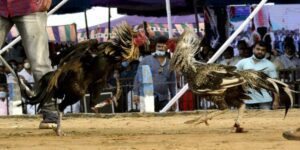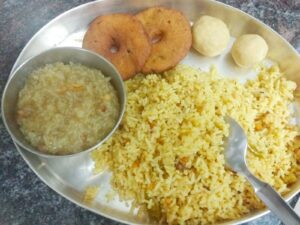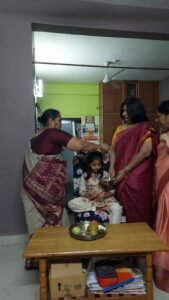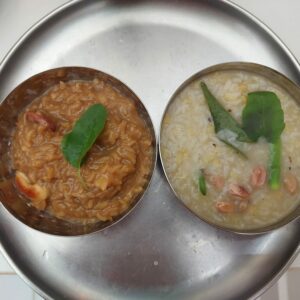Beyond caste and cockfight rituals, families from Andhra Pradesh, Telangana and Karnataka share the rituals and customary traditions of celebrating Makar Sankranti in an era were traditions were duly followed.

Makar Sankranti offers an opportunity to pause and return to our roots, think of our farmers, and the environment. (iStock/Supplied)
Over the next four days, a nationwide celebration will unfold in India to mark the transition from winter to spring. Makar Sankranti, Pongal, Bihu, Lohri… the names are many, but the spirit is common — to mark the beginning of the harvest season, and the sun’s northward journey.
For Hyderabad resident Seshabhattar Raghu, who has completed 69 trips around the sun, at the core of Makar Sankranti lies absolute reverence for the agrarian community.
“We owe this to our farmers, who dedicate their lives to bring us the best produce,” he says.
Makar Sankranti offers an opportunity to pause and return to our roots, think of our farmers, and the environment, and present our gratitude to the food that comes to our table from these farmlands, he says.

Every community in the village would assemble and enjoy Makar Sankranti, and fly kites together. (iStock)
Raghu grew up in a village in Gokavaram near Rajahmundry in the early 1950s and 1960s. It was a time when the caste system was not part of any festivals, he says.
“Every community in the village would assemble and enjoy Makar Sankranti, fly kites together, in the playground or school ground. There was no caste system. All the celebrations were harmonious and communal,” he recalls.
Sixty-two-year-old Bhanu Elapavuluru agrees with Raghu. Currently residing in Himayat Nagar, Elapavuluru, who was born in Vijaynagaram and brought up in Bhimavaram, remembers Sankranti as a festival of bonding beyond caste and class.
“Bhimavaram was known for its lavish Sankranti celebrations. As a family, we would honour our farmers and the produce we received. Sugarcane is the most important part of the festival. In the north of Andhra like Vijaynagaram and Vizag, sugarcane pieces are distributed to everyone,” she reminisces.
As traditions now take the shortcut to suit modern needs, Raghu is happy to relive his boyhood memories of attending cockfights and goat fights — a cultural spectacle — on the huge grounds in his village.

Every year, it is estimated that at least 2 lakh fighting roosters entertain spectators during the three-day festival. (Supplied)
“There are two types of cockfights — one with a knife and the other, without a knife. In the former, a knife is tied around the leg of the cock which fights the other cock and attempts to kill it,” he elaborates.
“Back in the early 1960s, I was a 13-year-old boy, adventurous and curious to watch this sport with my friends,” he laughs.
Women were not permitted to attend. But, Elapavuluru recalls being inquisitive and attending one such Kodi Pandem or Kodi Pandelu (cockfight) in Bhimavaram.
For Sangitha Kodithala, a 1990s child who grew up in Pembarthy village Jangaon district in Telangana, this culture is not a familiar terrain. But what she remembers is sitting with her large family and helping the elders to make Sakinalu — a traditional Telangana snack prepared with homemade rice flour and sesame seeds — during Sankranti.

Traditional meals of payasam, vadas, sesame laddoos, and ariselu are crucial to the festival. (Supplied)
“We would buy huge heaps of rice flour and spend all day making it. It is similar to kai murukku, made in three concentric circles. We would also make ladoos using sesame seeds, groundnuts, and fresh jaggery. And all this was prepared using the fresh harvest,” she shares.
Elapavuluru’s memory jogs back to being surrounded by family to prepare the Ariselu. “Ariselu is one of the main sweets for Sankranti made using the fresh harvest of rice, jaggery, ghee, and oil,” she informs.
Raghu, too, fondly recalls his mother’s pindi vantalu (assortment of sweets). Payasam, vadas, sesame ladoos, etc. were all customary delicacies on the Sankranti meal plate.

Bhogipallu is a ceremony for children when a mixture of Sankranti sweets are poured over their heads as blessings. (Supplied)
Bhogi, the first day of Sankranti, sets the mood to usher in the festivities in all these families. Cow dung cakes are prepared and placed at the entrance of their homes. Young girls draw muggu (rangoli) and adorn it with flowers. Discarded household items and wooden logs are collected and then burnt.
“We would all dance around the rangoli, singing gobbiyallo, gobbiyallo,” pitches in Raghu’s wife, Annapoorna.
On the evening of Bhogi, Bhogipallu is conducted for children up to seven years of age. “We make them wear new clothes, have them seated on a stool, and then pour a mixture of rice, and sugarcane pieces on their heads as blessings from the elders,” she shares.
The festival also holds significance for the sons-in-law, especially newlyweds. “A feast is prepared and the son-in-law is made to feel special. This is to keep him happy so that the daughter is treated well and taken care of,” informs Raghu.
He also fondly remembers the tradition of Prabhala Theertham, a festival in Konaseema region that is celebrated on Kanuma, the last day of Sankranti.
“My friends and I would run along the lake in Gangalakurru to lend a hand to pull the Prabhala. The ‘Prabhas’ are artistic creations made using teak planks, logs and bamboos. They resemble a gopuram. New clothes are weaved into the space between the frames. A thick red cloth is used to screen the back of the ‘Prabha’. The front of the ‘Prabha’ is known as ‘Jeevaatma’, while the one behind is called the ‘Paramatma’, he shares.
This tableau made its appearance in last year’s Republic Day Parade, he proudly recalls.

Sweet pongal or kichadi made using fresh harvest of rice, jaggery, and ghee is mandatory. (Supplied)
In Archana AS’s home in Mysuru, preparations for Sankranti begin 15 days before the festival day. Decluttering, cleaning and decking up the home takes all the attention. The entrance of the home is embellished with a toran made of mango leaves and a vibrant rangoli, she says.
Sankranti is also about good food. “As it is the peak of winter, sesame and jaggery-based sweets are common. We prepare kichadi (pongal) — a mixture of rice and lentils savoured with spices and ghee. We usually prepare both sweet and khara (spicy) pongal,” she shares.
The most important ritual of this festival is distributing Ellu Bella mix, she says.
Archana remembers watching her mother preparing the Ellu Bella ten days before Sankranti.
“This is a mixture of sesame, jaggery, fried gram, roasted peanuts and dry coconut pieces. My mom used to buy all the ingredients and cut them into small uniform pieces using a beetle-nut cutter. This is a tedious process and requires a lot of patience and time,” she narrates.
But, she is also quick to admit that patience is not a virtue with the current generation. Readymade, store-bought festive snacks and sweets are convenient, she says.
Another highlight of the day is Ellu Beerodu — sharing the Ellu Bella mix with friends, neighbours and relatives.
“Everyone dresses up in new clothes to distribute this mix. We usually carry a plate with the mix in a small container, sakkare acchu (sugar candy), sugarcane pieces, elche hannu (jujube fruits), flowers, betel nut and betel leaves, turmeric-vermillion pack, and some fruits,” she details.
At the time of exchanging the plate and pleasantries, Kannadigas greet by saying, Ellu Bella Tindu Olle Maathadi (please eat the mixture of sesame and jaggery and speak good/sweet words.)
This exchange also symbolises the harvest of love and friendship, she shares.
On the evening of Sankranti, the women of the house gather and make a mixture of Ellu Bella, sugarcane pieces, elche hannu, flowers and coins. All this is filled in a paavu (a traditional vessel). Children below the age of 5 are dressed in new attire and offered aarti.
“This mix is then showered on their heads as blessings to protect them from evil eye and ward off drushti. The main reason behind this ritual is to pray for the children’s good health, prosperity and long life,” she adds.
Raghu, Elapavuluru, Kodithala and Archana worry that traditions and celebrations are losing their essence. With the migration to the cities and abroad, the spirit of the festival has dimmed over the years.
“Sons-in-law also have stopped coming home,” Raghu laughs.
Elapavuluru, too, can see the number of festive plates shrinking at home. With her children and grandchildren away, she now involves the children of her society’s security in following some of the traditions. “We have to keep the community mobilised. We cannot lose traditions,” she insists.
As all four work towards keeping the traditions alive, here’s hoping that this harvest season, communities nurture an ecosystem where our crops and farmers can thrive.

May 19, 2024

May 19, 2024

May 19, 2024

May 19, 2024

May 19, 2024

May 19, 2024